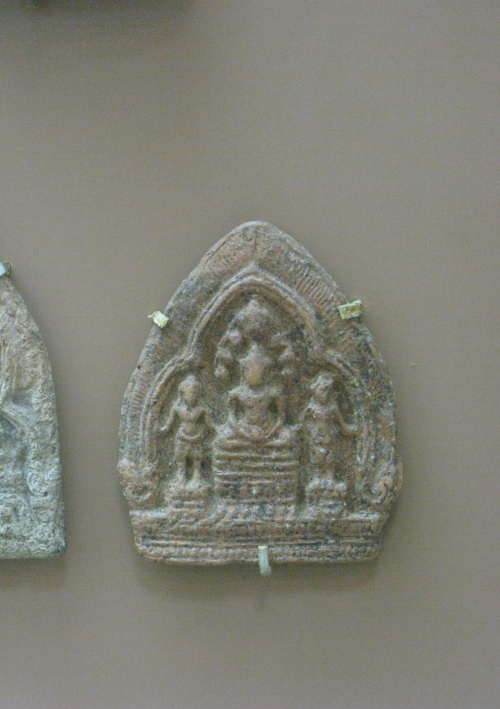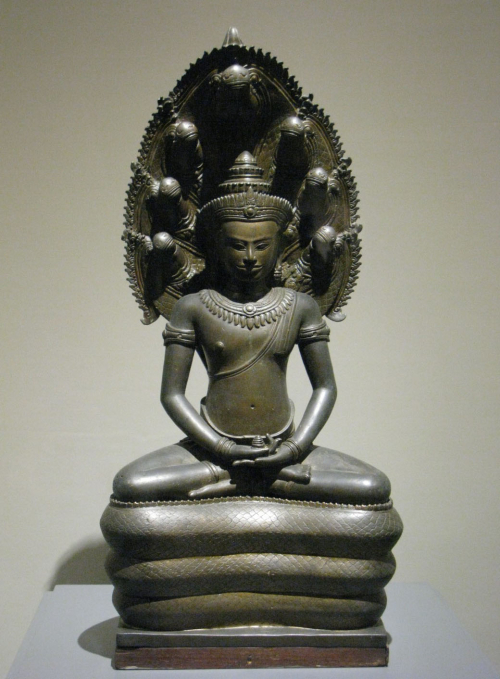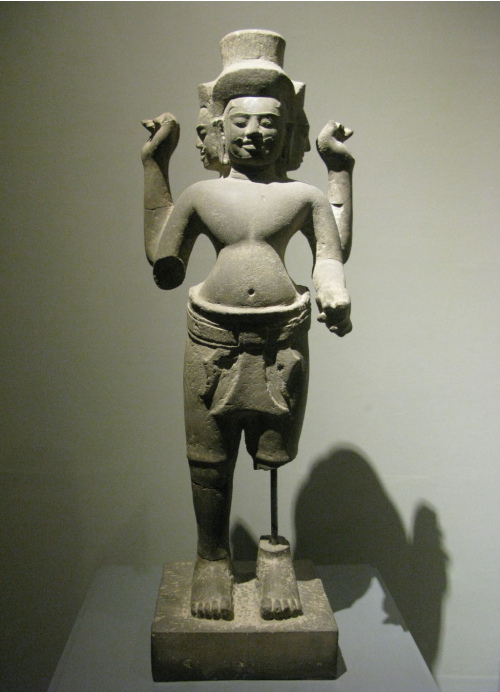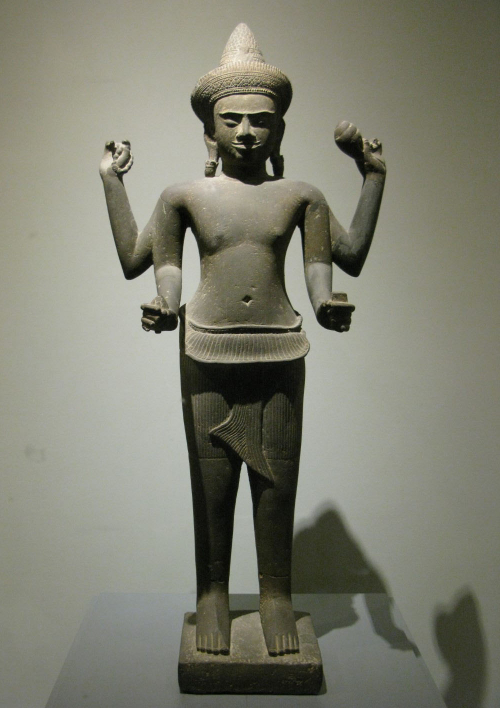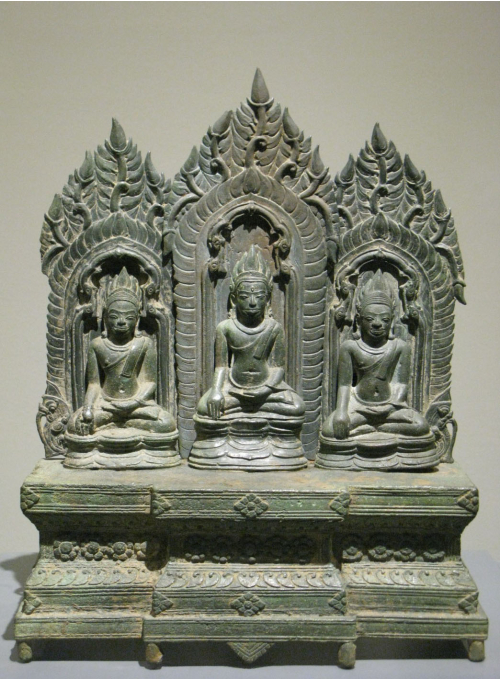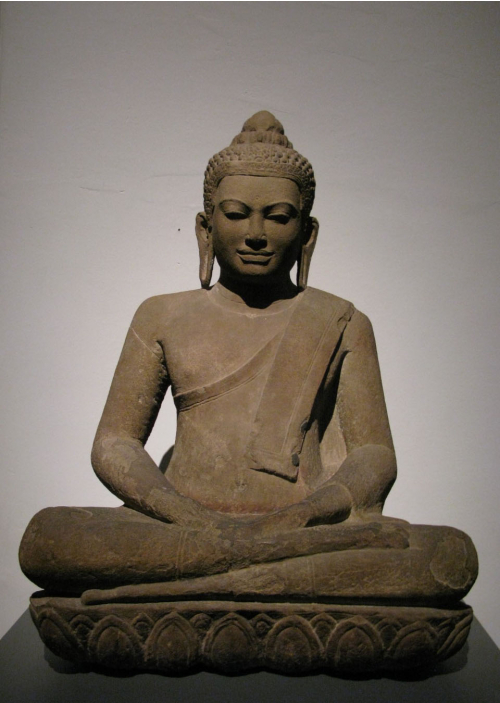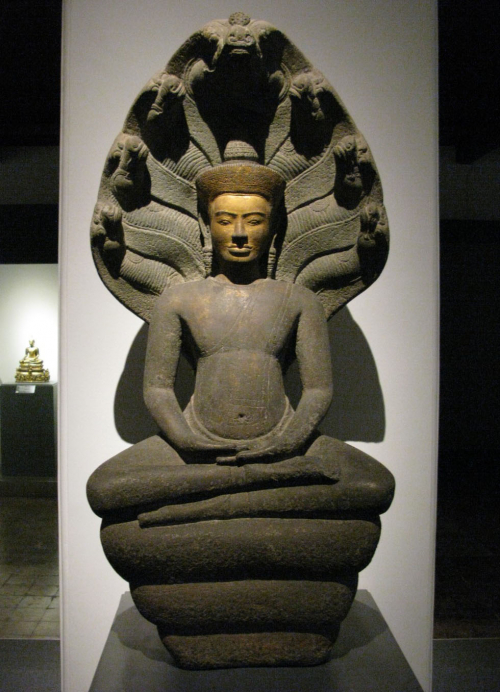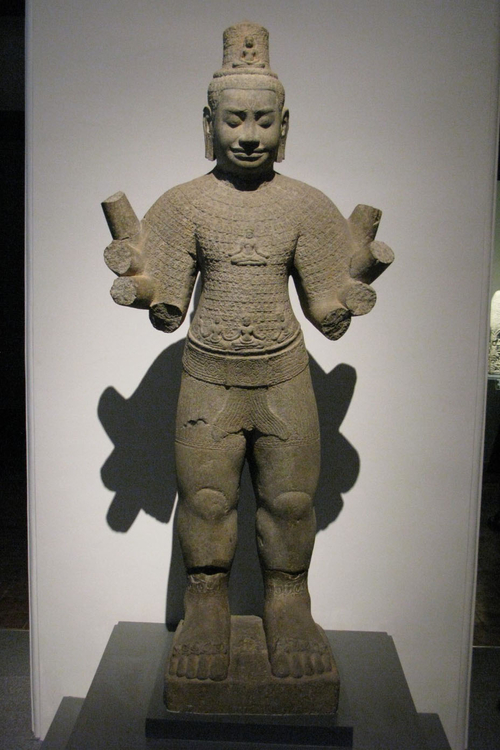ค้นหางานศิลปกรรม
ฐานข้อมูลศิลปกรรมในเอเชียตะวันออกเฉียงใต้
ประติมากรรมพระพิมพ์ดินเผา
พระพิมพ์ทรงคล้ายสามเหลี่ยม ตรงกลางเป็นพระพุทธรูปนาคปรก เบื้องขวาของพระองค์เป็นบุรุษเชื่อว่าเป็นพระโพธิสัตว์อวโลกิเตศวร เบื้องขวาของพระองค์เป็นสตรีเชื่อว่าเป็นพระนางปรัชญาปารมิตา มีกรอบคดโค้งทำนองเรือนแก้วล้อมรอบประติมากรรมทั้งสาม เบื้องล่างรองรับด้วยเป็นฐานบัว
ประติมากรรมพระพุทธรูปนาคปรก
พระพุทธรูปอยู่ในอิริยาบถนั่งขัดสมาธิราบ พระหัตถ์ทำปางสมาธิ ประทับอยู่บนขนดนาค เบื้องหลังมีพังพานนาคปรกไว้พระพักตร์เหลี่ยม สวมเครื่องทรงมากชิ้น ได้แก่ กุณฑลทรงตุ้มแหลม กระบังหน้าและรัดเกล้ากรวยอันประกอบด้วยชั้นลดหลั่นของแถวกลีบบัว เป็นหนึ่งในลักษณะเด่นของพระพุทธรูปศิลปะเขมรแบบบายน สวมกรองศอ พาหุรัด ทองพระกร แม้ว่าพื้นที่ระหว่างพระกรกับพระวรกายจะเจาะทะลุทำให้เกิดความรู้สึกว่าเปล่าเปลือย อันเป็นลักษณะเด่นของพระพุทธรูปศิลปะลพบุรี ทว่ากลับปรากฏขอบจีวรเฉวียงพระอุระและชายจีวรสี่เหลี่ยมพาดอยู่บนพระอังสาซ้าย ภายในพระหัตถ์ขวามีตลับกลมวางอยู่ ขนดนาครองรับพระพุทธองค์มี 3 ชั้น ชั้นบนมีขนาดใหญ่ที่สุด จากนั้นจึงลดหลั่นขนาดลงตามลำดับ ตกแต่งลวดลายคล้ายเกร็ดงู นาคมี 7 เศียร รูปทรงดังสามเหลี่ยมหรือใบโพธิ์ เศียรกลางใหญ่ที่สุด เศียรด้านข่างทั้งหกมีขนาดเท่ากันโดยหันขึ้นหาเศียรกลาง
ประติมากรรมพระพรหม
ประติมากรรมพระพรหมอยู่ในอิริยาบถยืนบนฐานหน้ากระดาน พระชงฆ์ซ้ายและพระกรขวาล่างชำรุดสูญหายพระพักตร์ทั้งสี่มีรูปแบบเหมือนกัน กล่าวคือ รูปพระพักตร์เหลี่ยม คิ้ว 2 ข้างเกือบเป็นเส้นตรงและคมเป็นสัน พระเนตรเบิกโพรง พระนาสิกใหญ่ พระโอษฐ์แบะ มีพระมัสสุอยู่เหนือพระโอษฐ์ พระฑาฐิกะสลักนูนเห็นเด่นชัดโดยสลักยาวต่อเนื่องจากพระกรรเจียก (ขมับ) พระฑาฐิกะบริเวณพระหนุ (คาง) เป็นมุมแหลม พระกรรเจียกเป็นมุมแหลม รูปแบบของพระพักตร์และองค์ประกอบต่างๆ ที่กล่าวมานี้เทียบได้กับประติมากรรมศิลปะเขมรแบบบาแค็ง กระบังหน้าขนาดใหญ่ไม่ประดับตกแต่งลวดลาย มวยพระเกศาทรงกระบอกไม่ประดับตกแต่งเช่นกัน พระวรกายช่วงบนเปล่าเปลือย มีสี่กร พระวรกายช่วงล่างนุ่งสมพตสั้น ชายผ้าพาดยาวอยู่ตรงกลาง มีเข็มขัดผ้ารัดที่บริเวณพระโสณี ปลายเข็มขัดผ้าห้อยตกลงมาเหนือพระอูรุ (หน้าขา) ผ้านุ่งเช่นนี้เทียบได้กับศิลปะเขมรแบบาแค็ง เพียงแต่ว่าพระพรหมองค์นี้ไม่มีเส้นริ้วตามแนวตั้งประดับผ้านุ่ง ซึ่งการประดับเส้นริ้วนี้เป็นสิ่งที่พบได้ในศิลปะเขมรแบบบาแค็ง
ประติมากรรมพระโพธิสัตว์อวโลกิเตศวร
พระโพธิสัตว์อวโลกิเตศวรยืนตรงบนฐานหน้ากระดาน พระพักตร์เหลี่ยม พระขนงคมเป็นสัน พระเนตรเบิกโพรง พระนาสิกและพระโอษฐ์สมส่วน สวมกุณฑลทรงตุ้มแหลม สวมกระบังหน้าและรัดเกล้ากรวยเทียบได้กับเทวรูปในศิลปะนครวัด กึ่งกลางของรัดเกล้ามีร่องรอยพระพุทธรูปซึ่งถูกกะเทาะรายละเอียดออก พระพุทธรูปที่รัดเกล้าทำให้เชื่อว่าประติมากรรมนี้เป็นรูปพระโพธิสัตว์อวโลกติศวร เพราะเป็นหนึ่งในสัญลักษณ์ประจำพระองค์ โดยพระพุทธรูปนี้คือพระธยานิพุทธเจ้าอมิตาภะ ผู้บันดาลให้พระโพธิสัตว์อวโลกิเตศวรถือกำเนิดขึ้นมาพระวรกายด้านบนเปล่าเปลือย พระวรกายด้านล่างสวมพตสั้น สลักลายเส้นตรงทำให้เหมือนเป็นผ้าอัดกีบ ชักชายผ้าเป็นวงโค้งบริเวณใต้พระอุทร และมีชายผ้าทรงคล้ายหางปลาพาดลงตรงกลาง ลักษณะผ้านุ่งดังกล่าวนี้เป็นรูปแบบของประติมากรรมในศิลปะแบบนครวัด พระกรทั้งสี่ถือสิ่งของต่างๆ ที่เป็นของประจำพระองค์ กล่าวคือ พระหัตถ์ขวาล่างถือดอกบัว พระหัตถ์ขวาบนถือประคำ พระหัตถ์ซ้ายล่างถือคัมภีร์ พระหัตถ์ซ้ายบนถือสังข์
ประติมากรรมพระพุทธรูป
ประติมากรรมชุดนี้ประกอบด้วยพระพุทธรูป 3 องค์นั่งเรียงกัน องค์กลางมีขนาดใหญ่ที่สุด ทุกองค์มีรูปแบบเช่นเดียวกัน กล่าวคือ นั่งขัดสมาธิราบ พระหัตถ์ทำปางมารวิชัย สวมมงกุฏแบบที่เรียกกันว่า เทริดขนนก กุณฑลตวัดงอน เครื่องทรงทั้งสองนี้น่าจะเกี่ยวข้องกับศิลปะอินเดียแบบปาละ ทั้งนี้อาจรับมาโดยตรงหรือรับผ่านศิลปะพม่าแบบพุกามหรือศิลปะหริภุญชัยทางภาคเหนือของไทยก็ได้พระพุทธรูปทั้ง 3 องค์ยังสวมกรองศอ ครองจีวรห่มเฉียง ชายสังฆาฏิสี่เหลี่ยมยาวจรดกึ่งกลางพระอุทร รองรับด้วยฐานบัวที่ตกแต่งกลีบบัวคว่ำบัวหงาย 3 แนว พระพุทธรูปทั้ง 3 องค์วางอยู่บนฐานบัวสี่เหลี่ยมยกเก็จที่กึ่งกลาง ฉากหลังของแต่ละองค์เป็นซุ้มเรือนแก้วแบบคดโค้งประดับด้วยใบระกา ปลายกรอบด้านนอกของเรือนแก้วด้านซ้ายและขวาทำรูปเศียรนาคคายอุบะ ถัดขึ้นไปจากเรือนแก้วเป็นกิ่งก้านสาขาของต้นไม้ เข้าใจว่าอาจหมายถึงต้นโพธิ์
ประติมากรรมพระพุทธรูปปางสมาธิ
พระพุทธรูปอยู่ในอิริยาบถนั่งขัดสมาธิราบบนฐานบัว พระหัตถ์ทำปางสมาธิ พระพักตร์แลดูสี่เหลี่ยม สีพระพักตร์สงบ พระเนตรเหลือบต่ำ พระขนงโก่งกว่าพระพุทธรูปศิลปะลพบุรีทั่วไป พระนาสิกและพระโอษฐ์สมส่วน มีพระอุณาโลมกลมอยู่กึ่งกลางพระนลาฏ ปรากฏแถบไรพระศกที่พัฒนามาจากกระบังหน้าคาดอยู่เหนือพระนลาฏ เป็นหนึ่งในจุดสังเกตที่สะท้อนถึงความแตกต่างไปจากศิลปะลพบุรีทั่วไป พระเกศาเวียนเป็นวงก้นหอย พระอุษณีษะเป็นทรงกรวยแหลม ครองจีวรห่มเฉียง สังฆาฏิสลักนูนเด่นอยู่ในทรงสี่เหลี่ยมขนาดใหญ่พาดอยู่บนพระอังสาซ้าย ฐานบัวที่รองรับพระพุทธองค์ปรากฏแต่เพียงลายกลีบบัวหงาย
ประติมากรรมพระพุทธรูปนาคปรก
พระพุทธรูปอยู่ในอิริยาบถนั่งขัดสมาธิราบอยู่เหนือขนดนาค พระหัตถ์ทำปางสมาธิ พระพักตร์สี่เหลี่ยม สีพระพักตร์เข้มขรึม พระเนตรเบิกโพรง สวมมงกุฎอันประกอบด้วยกระบังหน้าและรัดเกล้ากรวย สวมกุณฑลทรงตุ้มแหลมพระวรกายช่วงบนเปล่าเปลือยสังเกตได้จากการปรากฏช่องทะลุระหว่างพระปรัศว์ (สีข้าง) กับพระกรทั้งสองข้าง ขณะเดียวกันก็ปรากฏลายเส้นสลักลึกเป็นรอยจีวรแบบห่มเฉียงและสังฆาฏิสี่เหลี่ยมใหญ่ เข้าใจว่าอาจสลักเพิ่มเติมภายหลัง พระวรกายช่วงล่างครองสบง นาคปรกเบื้องหลังพระเศียรอยู่ในโครงคล้ายใบโพธิ์ มี 7 เศียรโดยเศียรกลางมีขนาดใหญ่ที่สุดในขณะที่เศียรด้านข้างข้างละ 3 เศียรมีขนาดเล็กกว่า ทั้งหมดหันหน้าเข้าหาเศียรกลาง ขนาดนาคที่รองรับพระพุทธองค์มี 3 ขนด โดยขนดบนมีความกว้างและหนาที่สุด จากนั้นจึงลดหลั่นขนาดลงมาทำให้เส้นรอบนอกเป็นทรงสอบ
ประติมากรรมพระโพธิสัตว์อวโลกิเตศวรเปล่งรัศมี
พระโพธิสัตว์อวโลกิเตศวรเปล่งรัศมีอยู่ในอิริยาบถยืนตรงบนฐานหน้ากระดานสี่เหลี่ยม สภาพสมบูรณ์มากมีเพียงพระกรทั้งแปดที่หักหายไป พระพักตร์เหลี่ยม พระเนตรปิด แย้มพระโอษฐ์เล็กน้อยตามอย่างศิลปะเขมรแบบบายน ทำให้เกิดความรู้สึกสงบ เกล้าพระเกศาเป็นมวยทรงกระบอก มีรูปพระพุทธเจ้าอมิตาภะประดับมวยผม และมีพระพุทธรูปจำนวนมากประดับพระเศียรแทนเส้นพระเกศา พระองค์ส่วนบนประดับด้วยแถวพระพุทธรูปจำนวนมากมายราวกับเป็นเกราะ กึ่งกลางพระอุระและบั้นพระองค์ปรากฏรูปบุคคลขนาดใหญ่ อาจหมายถึงนางปรัชญาปารมิตา พระกรทั้งแปดหักหายไปแล้ว สวมสมพตสั้นที่สลักลวดลายอย่างคร่าวๆ ช่วงล่างของพระองค์ตั้งแต่พระอูรุ (ต้นขา) จนถึงพระบาทใหญ่ผิดสัดส่วน สวมธำมรงค์ที่นิ้วพระบาททั้งสิบ
